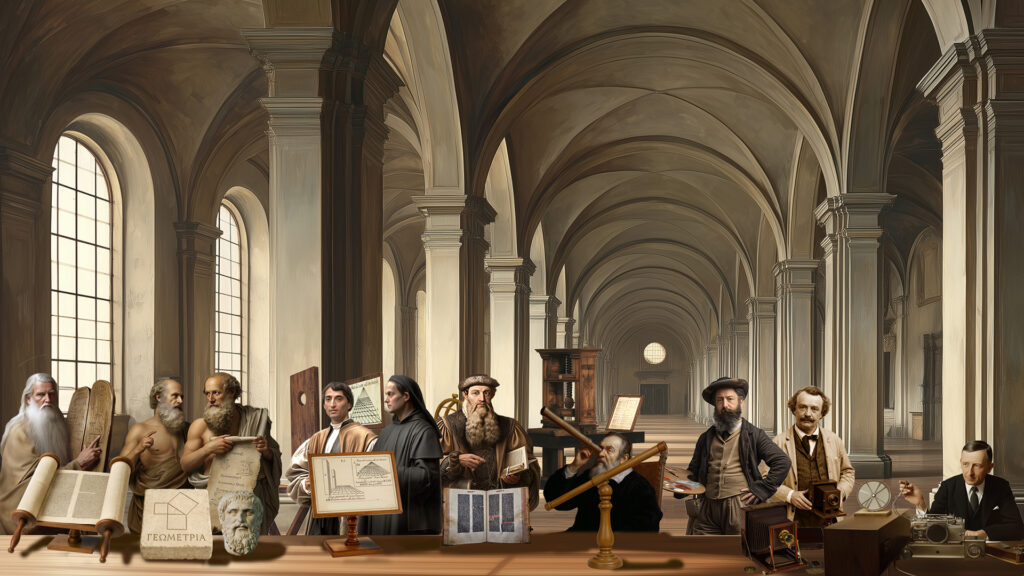We are facing a cognitive revolution, enabled by Artificial Intelligence. This epochal shift requires an evolutionary leap in human intelligence, which must extend its faculties to adapt to and take control of a new ecosystem.
Brief history of techno-cognitive revolutions
In the evolution of human intelligence, the greatest mutations can be traced to genius personalities who were able to interact correctly with cognitive technologies. Examples include the early Greek philosophers in the ancient era, the scientists of the experimental method in the modern age, and the precursors of contemporary art.
Historical precedents can be very useful in understanding how humans will be able to face and meet the challenge with the cognitive technology of Artificial Intelligence, which comes with disturbing aspects that are difficult to interpret and predict.
It is unthinkable to analyze in detail the timing of the invention of language, which engaged several hominid species over a very long time span in the Paleolithic, certainly hundreds of thousands of years.
The invention of writing also took several thousand years, and took various pictographic, ideographic, syllabic and phonetic forms.
Archaeology identifies the birth of the first phonetic alphabet in the Proto-Sinaitic script, invented by a Semitic population that adapted some Egyptian hieroglyphic signs to express the sounds of their own language.
This archaeological indication finds an evocative literary match in the Biblical account of the advent of writing on Mount Sinai, in the context of the Exodus of the Hebrew people, led by Moses fleeing Egypt. Raised in the Egyptian court, Moses is the protagonist of a technical and spiritual revolution at once, which with the introduction of the alphabet and the tablets of the law inaugurated the religion of the book, a culture still shared after three millennia by Jews, Christians and Muslims.
There is an obvious relationship between the new writing technology and the new kind of intelligence, which comes to change the structure of the human mind (psyche). In his latest book, “The Man Moses and the Monotheistic Religion,” Sigmund Freud seems to intuit that the Israelites at the time of Moses invented the alphabet, and writes, “Among the precepts of the Mosaic religion is found one that is more important than one recognizes at first glance. It is the prohibition against making images of God, the imposition of worshiping a God whom no one can see. (…) when this prohibition was accepted, it had to exert a profound effect. It means in fact to postpone sensory perception to so-called abstract representation, a triumph of spirituality over sensibility, strictly speaking a pulsional renunciation with the necessary psychological consequences.”
We witness at Sinai a Media war: the winning Medium is alphabetical writing, the losers are images (idols) and orality (myth), outdated protagonists of prehistory. The idol of the golden calf (Aleph in Hebrew, the god Bees in Egypt) is destroyed and replaced by the alphabetic letter (Alef, then Alpha and A).
The people of the book, the Jews, were the first to introduce not only the alphabet (in the proto-Sinaitic form) but also compulsory schooling – related to the need to read Holy Scripture and extended to women as well – as early as the time of Moses and the Judges. The Jews, even after the destruction of the temple and in the Diaspora, continued to be literate even in the dark ages when illiteracy prevailed in Europe, thanks to the transcription of the Mosaic law, the Torah, which also made it possible to preserve the Hebrew language as a living fossil. Their identity for centuries is defined not by a land, but by a book.
Turning to today’s debate on Singularity, the supposed future surpassing of Artificial Intelligence over human intelligence, it should be noted that even in the past the advent of the alphabet has been associated with an intelligence considered superhuman, what in the Bible is called the “word of God,” the expression of the superhuman and eternal being who guided mankind with his precepts.
The technique of writing not only generates the law, but also makes possible the invisible, monotheistic form of divinity, the one God who speaks through “holy writing” (undoubtedly alphabetical) and has since been shared by the three great “religions of the book” (Judaism, Christianity, Islam). The first and second commandments of the law prohibit images…


